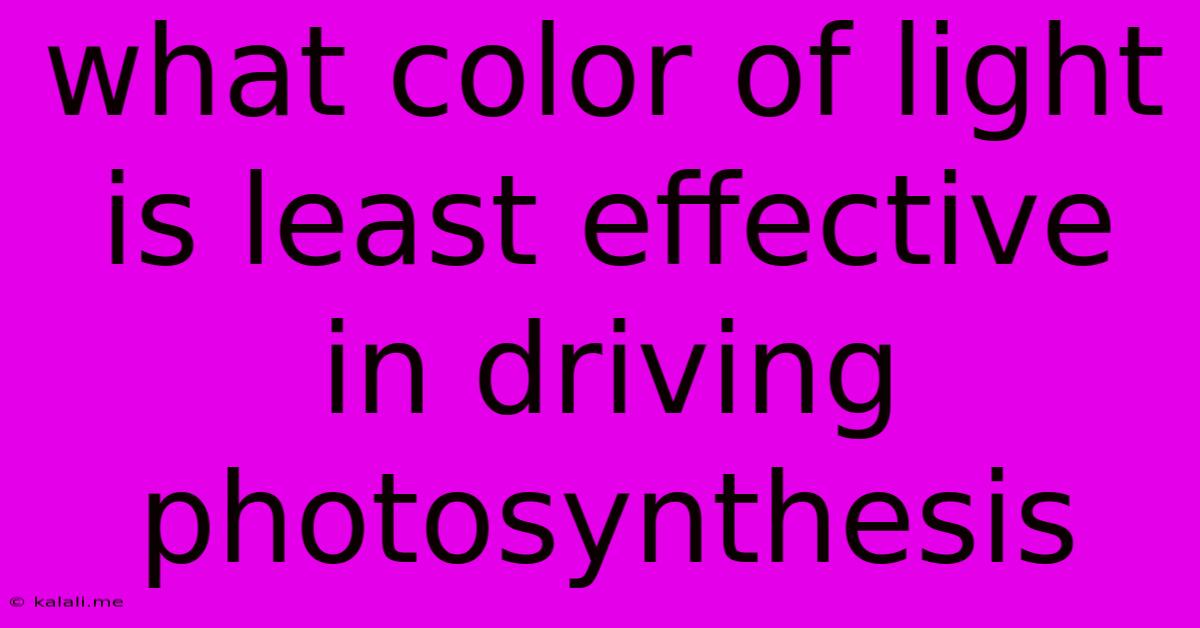What Color Of Light Is Least Effective In Driving Photosynthesis
Kalali
Jun 15, 2025 · 3 min read

Table of Contents
What Color of Light is Least Effective in Driving Photosynthesis?
Meta Description: Discover which color of light is least effective for photosynthesis and why, exploring the science behind plant light absorption and the implications for plant growth. Learn about the electromagnetic spectrum and chlorophyll's role in this crucial process.
Photosynthesis, the process by which plants convert light energy into chemical energy, is fundamental to life on Earth. Understanding which wavelengths of light are most and least effective in driving this process is crucial for optimizing plant growth, whether in a garden, greenhouse, or even controlled laboratory settings. So, which color of light is least effective? The answer lies in understanding how plants absorb light.
The Electromagnetic Spectrum and Chlorophyll
Sunlight is made up of a spectrum of electromagnetic radiation, encompassing various wavelengths perceived by humans as different colors. Plants primarily use chlorophyll, a green pigment, to absorb light energy. This chlorophyll absorbs light most strongly in the blue (around 450 nm) and red (around 670 nm) portions of the spectrum.
Why Green Light is Least Effective
Since chlorophyll absorbs blue and red light most efficiently, it reflects green light. This is why plants appear green to our eyes. Because green light is largely reflected rather than absorbed, it contributes the least to photosynthesis. This means that while plants can use some green light, its effectiveness in driving photosynthetic processes is significantly lower compared to blue and red light.
Other Factors Affecting Photosynthesis
While green light is generally the least effective, other factors significantly influence photosynthesis rates:
- Light Intensity: The amount of light available affects the rate of photosynthesis. Too little light limits photosynthesis, while excessive light can damage the plant's photosynthetic machinery. This concept is related to the law of diminishing returns.
- Light Duration (Photoperiod): The length of the light period influences flowering and other developmental processes in plants. The response varies greatly depending on the plant species.
- Chlorophyll Concentration: Plants with higher concentrations of chlorophyll generally have higher rates of photosynthesis, assuming sufficient light is available.
- Temperature: Photosynthesis is an enzyme-driven process and temperature affects enzyme activity. Optimal temperatures vary among plant species.
- CO2 Availability: Carbon dioxide is a crucial reactant in photosynthesis. Higher CO2 concentrations, up to a certain point, can increase photosynthetic rates.
- Water Availability: Water is vital for photosynthesis and water stress can significantly reduce photosynthetic efficiency.
Implications for Plant Growth and Cultivation
Understanding the spectral preferences of photosynthesis has led to the development of specialized grow lights for indoor gardening and horticulture. These lights often focus on emitting higher proportions of blue and red light, maximizing photosynthetic efficiency and optimizing plant growth. However, a balanced spectrum is important for healthy plant development, as the complete spectrum promotes better overall plant health and vigor.
Conclusion
In conclusion, while plants can utilize green light to some degree, it is the least effective color in driving photosynthesis compared to blue and red light. This is primarily due to the absorption characteristics of chlorophyll, the primary pigment responsible for light absorption in photosynthesis. Understanding this spectral preference allows for optimizing plant growth through tailored lighting strategies. This knowledge is crucial for both hobbyists and professionals involved in cultivating plants, demonstrating the practical application of this fundamental biological process.
Latest Posts
Latest Posts
-
Which Of The Following Contains Both Ionic And Covalent Bonding
Jun 15, 2025
-
Consider The Parallel Plate Capacitor Shown In The Figure
Jun 15, 2025
-
Factors Of 225 That Add Up To 30
Jun 15, 2025
-
Bond Order Formula For Resonance Structures
Jun 15, 2025
-
Which Of The Following Is Not A Primary Color
Jun 15, 2025
Related Post
Thank you for visiting our website which covers about What Color Of Light Is Least Effective In Driving Photosynthesis . We hope the information provided has been useful to you. Feel free to contact us if you have any questions or need further assistance. See you next time and don't miss to bookmark.